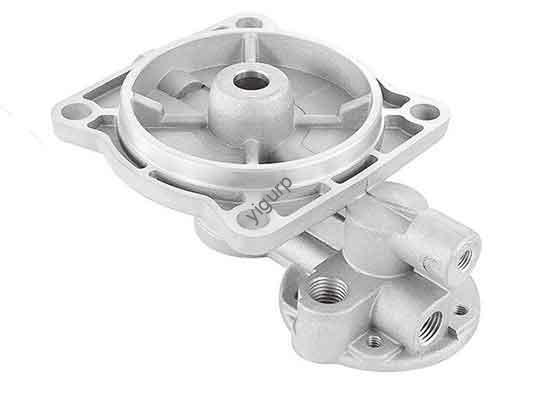If you’re developing prototypes or small-batch parts in Singapore, moulage à vide (également appelé moulage d'uréthane) est un changeur de jeu. It uses a vacuum to draw liquid resin into silicone molds, creating high-precision parts that mimic production-grade materials—faster and cheaper than injection molding. For local businesses, it cuts R&D time by up to 50% and slashes tooling costs to 20-30% of traditional methods . Si vous êtes en automobile, électronique, ou dispositifs médicaux, it bridges the gap between prototypes and market-ready products.
Comment fonctionne la coulée sous vide: Une ventilation étape par étape
The process is straightforward but requires precision—here’s how Singaporean manufacturers execute it:
- Création de motifs de maître
D'abord, a master model of your part is made using 3D Impression ou Usinage CNC. Singaporean shops like RP World often use 3D printing for complex designs, ensuring the master matches your CAD file exactly . The master is inspected for flaws before moving forward.
- Fabrication de moisissures en silicone
The master is submerged in liquid silicone, which cures around it (typiquement 24-48 heures). Once set, the mold is cut into two halves, and the master is removed—leaving a cavity that mirrors your part. These molds last 10-20 usages, en fonction de la complexité .
- Moulage à vide & Durcissement
Résine (Par exemple, polyuréthane) is poured into the mold, which is then placed in a vacuum chamber to eliminate air bubbles (critical for clear or detailed parts). The mold goes into an oven for 3-4 hours of constant-temperature curing . Enfin, le moule est ouvert, and the part gets post-processed (peinture, marquage laser, etc.).
Exemple de cas: A global automation firm in Singapore struggled with CNC-machined impeller assemblies that failed underwater tests. RP World switched to vacuum casting: they 3D-printed a master, made a silicone mold, and cast parts that passed long-term underwater trials—cutting production time by half and becoming the client’s long-term supplier .
Key Advantages of Vacuum Casting for Singapore Businesses
Why choose this over 3D printing or injection molding? Here’s how it benefits local teams:
- Vitesse: Get 20 des pièces dans 15 days or less —ideal for tight R&D deadlines.
- Rentabilité: Silicone molds cost far less than steel/aluminum injection molds. Pour 100 parties, vacuum casting saves 30-60% contre. moulage par injection .
- Qualité: Parts have superior surface finish (smoother than injection molding) and capture fine details like textures or undercuts .
- Flexibilité: Utiliser 11+ resin types (Par exemple, heat-resistant for automotive, transparent for lenses) and add post-processing like screen printing.
Top Materials for Vacuum Casting in Singapore
Singaporean suppliers offer a wide range of resins to match your part’s needs. Here’s a quick guide:
| Type de matériau | Propriétés clés | Utilisations courantes |
| Hei-Cast PU 8150 | ABS-like rigidity | Enclos, cas |
| Axson PX 5212 | Transparent, haute clarté | Lentilles, couvertures d'affichage |
| Bond 8752 | Flexible (en caoutchouc) | Joints, portables |
| Résines haute température | Résistance à la chaleur (jusqu'à 200 ° C) | Pièces de moteur automobile |
Pour la pointe: Jucheng Precision, a Singapore-certified (OIN 9001, IATF 16949) shop, recommends Hei-Cast 8400 for parts needing both strength and impact resistance .
2025 Trends Shaping Vacuum Casting in Singapore
The industry is evolving fast—here’s what local businesses need to know:
- Automation & 24/7 Production
Shops like SM Metal Solutions are adding automated mold prep and part extraction, reducing human error and enabling round-the-clock production . This boosts output by 30% while cutting labor costs.
- AI-Powered Optimization
AI systems now analyze casting cycles to predict mold maintenance and reduce waste. Par exemple, AI can spot resin flow issues early, garantissant 99% of parts meet quality standards —critical for medical device makers.
- Eco-Friendly Resins
With Singapore’s strict sustainability rules, suppliers are adopting recyclable resins that cut waste to 5-10% (contre. 20-30% pour usinage CNC) . Look for shops using bio-based polyurethanes.
How to Calculate Vacuum Casting Costs in Singapore
Costs depend on four factors—use this breakdown to budget:
- Matériel (40-60% du coût total): PU resins cost SGD 20-50 par kg; high-temp resins go up to SGD 80/kg .
- Mold Fees: A small mold (10x10cm) costs SGD 300-500; large/complex molds reach SGD 1,500 .
- Volume: Unit costs drop 40% when producing 100 contre. 10 parties (spreads mold costs).
- Post-traitement: Painting adds SGD 5-15 par pièce; laser marking is SGD 2-8 par pièce .
Exemple: 50 ABS-like parts (10x5cm) avec peinture: ~SGD 1,800 total (moule: SGD 400, matériel: SGD 800, labor/post-processing: SGD 600).
Perspective de la technologie Yigu
“Vacuum casting is the unsung hero of Singapore’s manufacturing ecosystem. We’ve seen clients cut R&D timelines by 60% using this method—especially in electronics, where fast prototyping wins markets. The key is partnering with shops that combine ISO certifications with AI tools: they deliver consistent quality while keeping costs low. As sustainability rules tighten, we’re advising clients to prioritize eco-resins—they don’t just meet regulations but also appeal to green-conscious buyers. Pour les petits lots (10-500 parties), vacuum casting beats injection molding every time.”
FAQ: Vacuum Casting Singapore
Q: How long does vacuum casting take in Singapore?
UN: 7-10 jours pour les pièces simples; conceptions complexes (avec post-traitement) prendre 12-15 jours .
Q: Can vacuum casting make metal parts?
UN: No—stick to plastics/rubbers. Pour les métaux, Singaporean shops use die casting (Par exemple, SM Metal Solutions) .
Q: Is vacuum casting better than 3D printing?
UN: For functional prototypes or small batches, yes—parts have better material strength and surface finish . 3D printing is better for 1-5 parties.
Q: Which industries use vacuum casting most in Singapore?
UN: Automobile (impellers, logements), électronique grand public (caisses téléphoniques, portables), et médical (device enclosures) .
